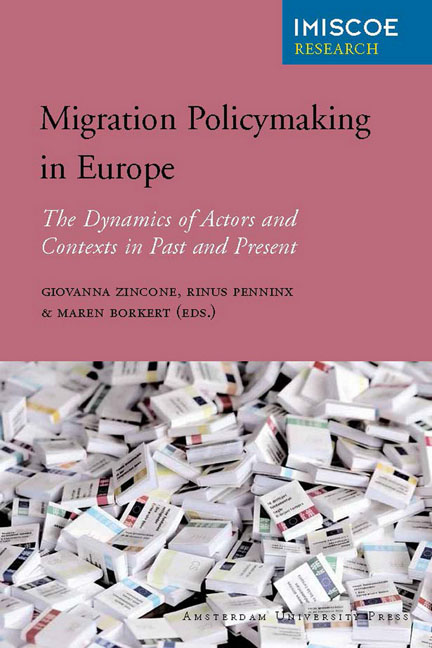Book contents
- Frontmatter
- Contents
- Policymaking in the Field of Migration and Integration in Europe: An Introduction
- Part I Post-War Migration Countries
- Part II Mediterranean Migration Countries
- Part III Eastern European Countries
- Conclusion: Comparing the Making of Migration Policies
- List of Contributors
- Other IMISCOE Titles
Conclusion: Comparing the Making of Migration Policies
Published online by Cambridge University Press: 20 January 2021
- Frontmatter
- Contents
- Policymaking in the Field of Migration and Integration in Europe: An Introduction
- Part I Post-War Migration Countries
- Part II Mediterranean Migration Countries
- Part III Eastern European Countries
- Conclusion: Comparing the Making of Migration Policies
- List of Contributors
- Other IMISCOE Titles
Summary
Introduction
As the introductory chapter of this volume stated, there is substantial literature on migration and immigrant policies, but very little on the processes by which such policies come about. The contributors to this volume are trying to take a step towards filling that gap. We have done this in the first place by presenting as case studies ten analytical chapters on European countries and their immigration and integration policymaking in recent decades. These country reports are based on a common analytical framework that is, in turn, derived from a state-of-the-art study that I co-wrote (Zincone & Caponio 2006). In it, the literature review was structured according to levels (national, local, international – notably at the EU level), directions of interactions between those levels (top-down, bottom-up, horizontal) and relations between public actors and civil society, which is commonly accepted as a second meaning of top-down.
Our review took a multitude of actors into consideration. We looked not only at the traditional legislative powers of the state, but also the informal activities of formal actors, such as de facto legislative initiatives by civil servants and the innovative interpretation of the magistracy, particularly supreme courts. Semiformal actors, such as unions, employers’ associations and representatives of religious denominations, and informal actors, such as pro- or anti-immigrant movements, NGOs, think tanks and experts, were also defined as being potentially relevant for policymaking. The labelling of actors as formal, informal and semiformal may vary in different countries: employers, trade unions and churches can be classified alternatively as informal or semiformal actors, depending on their level of inclusion in the public decision-making process.
All these elements formed part of the common analytical frame for the country cases. In this chapter, I will try to deepen the scope of the comparative analysis. I will do this in a somewhat unorthodox way, not by summarising the preceding chapters, but by asking two fundamental questions on comparing policymaking. The first refers to the question of change or continuity in policies and the factors and actors that provoke or inhibit change. The second asks whether there is convergence, and what policymaking factors and actors stimulate or inhibit convergence.
- Type
- Chapter
- Information
- Migration Policymaking in EuropeThe Dynamics of Actors and Contexts in Past and Present, pp. 377 - 442Publisher: Amsterdam University PressPrint publication year: 2012



